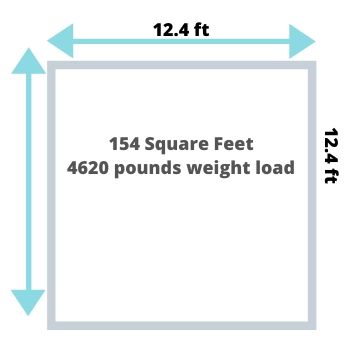This website is supported by its readers. If you click one of my links I may earn a commission. I am also a participant in the Amazon affiliates programme and I will also earn a commission from qualified purchases.

Let’s paint a picture. You’ve finally bought ( or rented) a brand new place, you’ve got a spare room that you can use for a home office, crammed it with loads of furniture and all of a sudden, your floor gives way! Okay might not sound super realistic but knowing how much weight your home office can hold can help you plan out what to buy going forward.
A home office can hold 30 – 40 pounds (13-18 kilos) per square foot on a second floor. A properly designed office is able to hold upwards of 50 pounds (22.6) kilos per square foot.
Is it safe to build your office on the first or second floor? What items will take up the most amount of room when designing an office?
Keep reading to find out more.
(Just a heads up a lot of people reading my blog are in the process of designing their own home office. If you want to save some of the painstaking time I did in designing my office, you can find my recommended products here)
How much weight can your home office hold?
Kind of a funny question do you think? I mean you’re not an engineer most likely you’re not looking to buy a huge piece of machinery for your home office so why is this important to know?
Well believe it or not ceilings do sometimes crumble. I remember one of my friends telling me how they were using the bathroom and their foot went straight through the floor… the hole was so big their neighbors below could see my friends flat through the gap in the ceiling!
Look around your house, look at your ceiling, you might notice some faint cracks or lines going across them from the weight pressing down on top of it.
You never want to be in a situation where you buy an item that might cause that crack to get exponentially bigger.
So exactly how much weight can a home office hold; I set up a meeting with two of my friends both of whom work in the engineering sector. One a chemical engineer, who is used to designing pressure systems and the other a mechanical engineer who focuses on weight bearings for things like bridges.
They pointed me to the American Wood Council who specified that first floor rooms can typically hold weight between 30-40 pounds (13-18 kilos). Ground floors can typically hold a lot more weight (50 Pounds (22.6) kilos but because of the effects of gravity and your house foundations, this is likely to be much much higher.
Doing the math
Using the 30-40 pounds math above let’s do the calculations for the US and UK markets.
UK Housing
So this is a little bit difficult as according to the LABC who have done a great job breaking down the changing in room size over time, there is no real average for a spare bedroom ( the room in which most home offices are based)
However, taking an average of all of their sizes the average spare bedroom is 14.34m2 or 154 Square feet.
This means that this would be able to hold 4620 pounds (2095 KG) of weight.

US Housing
This was a lot easier to find with Doorways magazine highlighting that the average US spare bedroom is 11 feet by 12 feet or 132 square feet or 12.2 Meters Square
This means that this would be able to hold 3960 pounds (1342 KG) of weight.

Does it matter what material your floor is made out of?
Now this is a super interesting question. Not all home offices are made equal and neither is the flooring that they reside on.
Some people have traditional floorboards with a bit of plasterboard/MDF to make their ceiling look pretty.
Others have solid concrete and steel beams as their flooring ( lucky you!) As such the weight loads that they can hold are going to be super different. How different?
According to Hunker, the best way to check this is by looking under your carpet and on your floorboard for a stamp on the joist that indicates the lumber’s species and grade.
You then need to use a design value table and a span table to understand exactly how much weight your floorboards can hold.
Concrete is a little bit different but generally can hold a lot more weight with some, if poured to the right measurements, being able to handle 2200 – 5000 PSI – that’s pounds per square inch!
Think about it, most concrete is used to support your house, and concrete floors are often used to support the weight of cars in garages, so they should be able to cover the weight of anything you put in your home office.
Is it safe to build a home office upstairs?
It is generally safe to build a home office on your second floor in a residential building. This is because home offices can support upwards of 3960 pounds (1342 KG) of weight in the average upstairs American home office.
Now that we know how much weight a floor can hold we can make the assumption that it is generally safe to build a home office upstairs without the floor caving in.
But what about other things we need to consider. For example, if you get something heavy like a standing desk in your workspace. You want to make sure you don’t injure yourself trying to get it up the stairs.
The same goes for filing cabinets. I’ve moved these before a flight of stairs and would not want anyone to have to experience that in their lifetimes.
On top of this, the amount of damage that can be done to your carpet and other aesthetics when moving your office around can be huge.
In my opinion, when moving heavy items it’s always worth getting in professional help rather than doing your back on when moving things.
If you do decide to go solo and do things yourself, the family handyman has a great post about this
What items will take up the most amount of weight when designing your home office?
So unless you’re going to put something like an aquarium in your home office it’s likely that the biggest weight will be your office desk, chair, and any storage like shelves.
Filing cabinets can typically weigh 150 pounds and weigh significantly more (potentially double) when there is more weight in them.
Office chairs tend to weigh about 250 pounds.
Office desks are tricky because of the wide variety that comes with them, but hopefully, the below graph should help.
I’ve also written a much more in-depth article about this that you can read here.
The average weight of a wooden desk is: 47.64 pounds (21.60kg)
| Desk Name | Weight | Height |
| Onespace Modern | 42 pounds (19.05kg) | 29 inches (73.66cm) |
| Homecho Writing | 55.9 pounds (25.35kg) | 37.8 inches (96cm) |
| Ironck Desk | 44.8 pounds (20.32kg) | 29.7 inches (75.43cm) |
| Ironck 55inch | 44.8 pounds (20.32kg) | 29.9 inches (75.43cm) |
| SHW L Shaped | 50.7 pounds (22.71kg) | 28.3 inches (71.88cm) |
The average weight of metals desks is: 50.16 pounds (22.75kg)
| Desk Name | Weight | Height |
| Tribesigns L shaped | 70.5 pounds (31.97kg) | 49.2 inches (124.96cm) |
| Onespace Stanton Computer Desk | 28.6 pounds (12.97kg) | 22 inches (55.88cm) |
| Elegant 55inch | 54.7 pounds (24.81kg) | 27.5 inches (69.85cm) |
| Yoleo Tower Computer Desk | 40 pounds (18.14kg) | 47.6 inches (120.90cm) |
| Walker Edison L Shaped | 57 pounds (25.85kg) | 29 inches (73.66cm) |
On average standing desks weigh: 42.75 pounds (19.39kg)
| Desk Name | Weight | Height |
| Vivo Adjustable | 38.3 pounds (17.37kg) | 48.8 inches (123.95cm) |
| Vivo Black | 42.5 pounds (19.27kg) | 36 inches (91.44cm) |
| Vivo Electric | 38.3 pounds (17.37kg) | 48.8 inches (123.95cm) |
| Seville Classics | 52 pounds (23.58kg) | 19.1 inches (48.51cm) |
Bear in mind however as I stated earlier most offices will be fine unless you’re filling it with huge items.
The cost of repairs when designing a home office
In an ideal world you will never have to worry about repairing the floor in your home office, but on the rare occasion that you do go over your weight limit and your floorboard do begin to break how much will the cost of repair be?
According to Homeadvisor, the average cost of floor repairs are in the region of $180 – $600 depending on the size and scale of the damage.
Wrapping things up
Hopefully, the article has put your mind at ease and you can rest assured knowing your home office will be able to handle the amount of weight you will place upon it. Although I have taken my engineering friends’ advice into consideration when writing this it’s worth mentioning that I am not a structural engineer.
It might be best, especially for a massive project getting a professional to give your room the quick once over before you make any decisions. As I’ve said many times, all rooms are different from one another.
Finally a lot of people reading my blog want to know what products I recommend for a home office/remote working. You can find out my recommendations here and learn how I make money whilst working remotely on the side here.
Hopefully, though you’re ready to go and you found the post useful.
Happy officing!
Fehed.
The content on this on this site has been written by Fehed Nicass who has over a decades worth of experience in sales and has worked remotely for the past 2 years.
